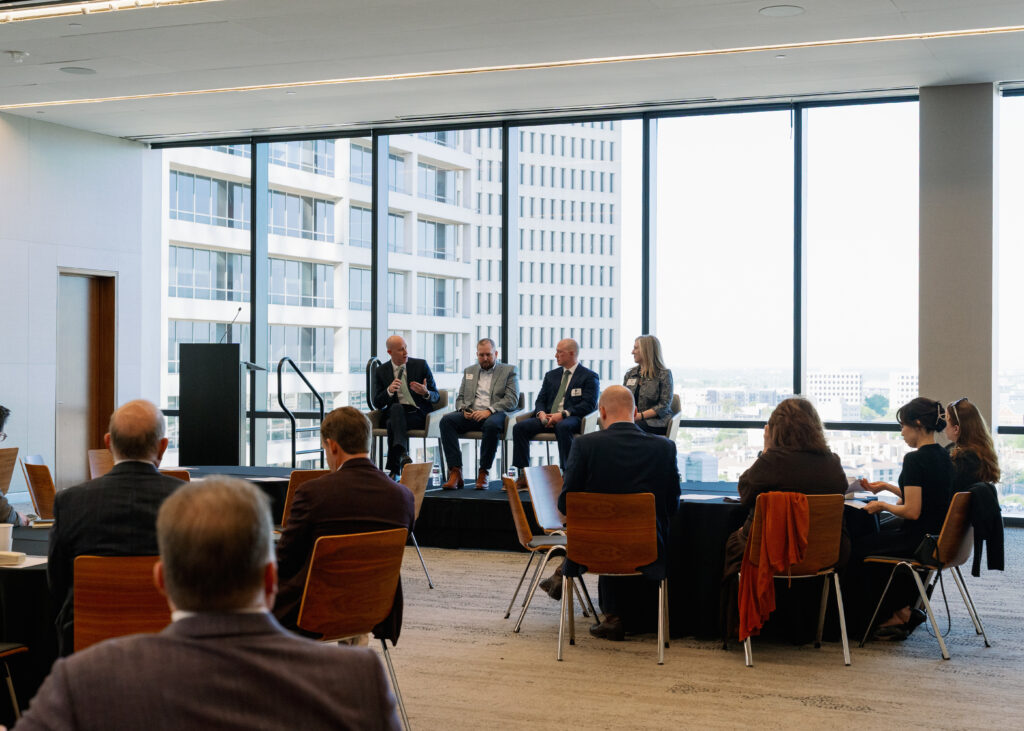Fort Worth EDP’s briefing focused on how strategic infrastructure is vital for economic growth. Local power, water, and infrastructure experts highlighted how strategic planning, public-private collaboration, and geographic advantages position Fort Worth to attract future development to the region.

By Katie McConnell, Associate | Monday, April 14, 2025
The Fort Worth Economic Development Partnership (EDP) convened its quarterly briefing last week, bringing together a network of EDP investors and key economic development stakeholders. The central focus of the discussion revolved around the foundational elements necessary for sustained economic growth—connectivity to power, secure water resources, and robust public infrastructure. The distinguished panel of speakers included Jes McEachern, Assistant City Manager for the City of Fort Worth, Dan Buhman, the General Manager of the Tarrant Regional Water District (TRWD), and Wilson Peppard, Oncor’s Director of Economic Development—each offering unique perspectives on these critical areas.
The program commenced with a warm welcome from Kacey Cornelius of Frost. Then, Robert Allen, the President & CEO of the EDP, officially opened the program. Following this, Spencer Mitchell, the EDP’s Vice President of Economic Development, briefed the crowd on emerging economic development trends observed throughout 2025. Notably, the recurring themes of “tariffs” and “manufacturing” echoed the nation’s broader economic landscape, highlighting some of the emerging factors influencing business decisions and investment.
After an overview of Fort Worth’s economic development pipeline, the panel discussion delved into the profound influence of infrastructure on attracting and fostering economic development. Oncor’s Wilson Peppard and TRWD’s Dan Buhman offered valuable insights into the intricate planning and implementation processes within their respective organizations, both emphasizing Fort Worth’s inherent infrastructural advantages. Jes McEachern further elaborated on the city’s strategic approach, explaining how the recent realignment of departments within her assistant city management portfolio is designed to enhance synergies and streamline local economic development efforts, ensuring a more coordinated and effective response to the needs of businesses.
When asked for his outlook on Fort Worth’s power infrastructure, Wilson Peppard of Oncor highlighted a crucial point—in today’s landscape, power availability is as much about the robust connectivity of the grid as it is about sheer generation capacity. Fortunately, Texas’s independent and more deregulated electricity environment presents distinct advantages for economic development initiatives. Peppard contrasted Texas’s streamlined 3- to 4-year timeline to build new transmission lines with the significantly longer 6- to 10-year timeframe often encountered in other states. He also addressed the evolving demands on the energy grid. While data center power requests makeup a large volume of requests to connect, increasing automation of manufacturing processes also drives larger power requests than previously seen in past decades. He confidently asserted that due to proactive and strategic planning efforts, Texas is well-positioned with “all the advantages” for power generation for the foreseeable future, providing a stable and reliable energy foundation for growth.
Shifting the focus to water resources, Dan Buhman of TRWD underscored the long-term vision required for sustainable water management. He explained that responsible water authorities operate with planning horizons spanning 50 to 100 years, a necessity driven by the extensive timelines involved in developing new water infrastructure. The total permitting timeline for a new reservoir, for instance, averages around 20 years, emphasizing the critical need for decades of foresight to guarantee water availability for future generations of Fort Worth residents and businesses. Buhman’s insights highlighted the proactive and strategic approach taken by TRWD to ensure the region’s long-term water security.
The comments from Wilson Peppard, Jes McEachern, and Dan Buhman collectively reinforced a fundamental principle—infrastructure drives development, and development drives the need for further infrastructure investment. Fort Worth’s advantageous geographic location near the power generation hubs of West Texas, coupled with TRWD’s 50-year water management strategy, strategically positions the region to successfully compete for and win significant economic development projects. This inherent strength is further amplified by the evident alignment and collaborative spirit between private entities like Oncor and public organizations such as the City of Fort Worth and TRWD, all working towards the future prosperity of the region’s infrastructure and, consequently, its economic landscape. The briefing concluded with a sense of optimism regarding Fort Worth’s preparedness to capitalize on future economic opportunities, underpinned by a strong foundation of strategic infrastructure planning and public-private collaboration.
—
The Fort Worth EDP is thankful for the support of its generous investors who share the EDP’s vision of making Fort Worth the most vibrant and sustainable city in the United States. If you’re interested in joining this team of investors or attending the Fort Worth EDP’s next Investor Briefing in April, please contact Chelsea@FortWorthEDP.com or visit the EDP’s About page.